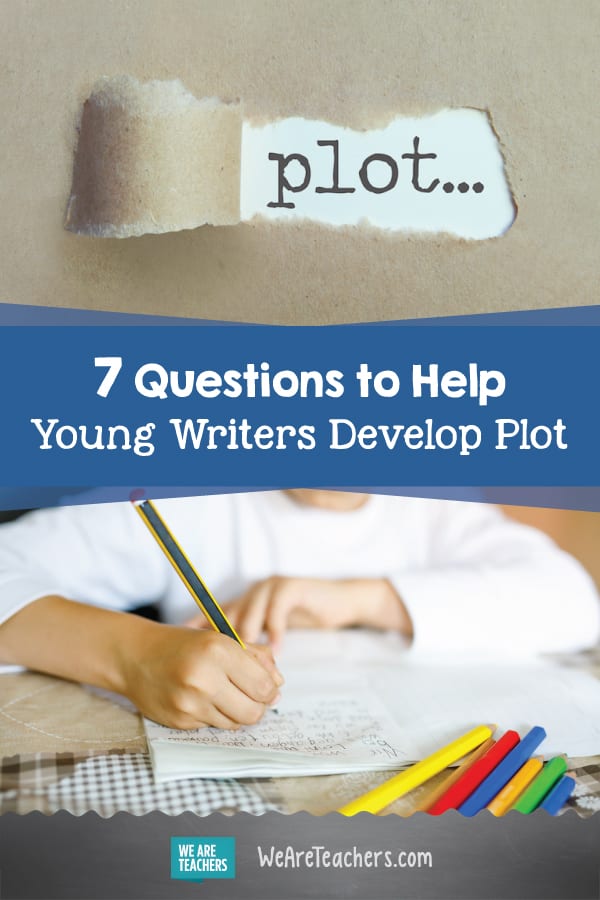I have some very important goals as a teacher of writing—I want my students to to improve their skills, I want them to appreciate the writing process, and I want them to learn what they need so that they can find success in whatever they choose to do with their lives.
But I also want to not hate grading the work that helps them reach those goals.
The more fun I have reading their work, the more willing I am to assign writing assignments, and the more opportunity they get to improve their writing. This means that I will go to great lengths to help my students write the most compelling pieces they can. So when I assign creative writing to my classes, I want to make sure that they understand the concept of plot.
But teaching plot isn’t always easy. It’s not enough to simply explain the required pieces or share a diagram with students—they need to understand how to integrate the elements into their own work.
Over the years, I have developed some questions for teaching plot.
I have found that they are quite effective in pushing students to structure their work so that a reader wants to read what they write. I usually have students complete these questions after they have gotten inspired and have a good idea of their topic. You might also use class time to answer these questions so that students can brainstorm together and ask you questions when they arise—and so that you can push them to think deeper when they want to answer superficially. Click here for a free printable PDF of these questions.
1. Who is your main character and what do they want?
This first question might sound obvious, but getting students to clearly state what their character wants goes a long way towards helping them to figure out the direction of their story.
2. Who or what is the antagonist—the person or thing that attempts to keep the main character from their goal?
Nothing kills a story’s plot faster than a main character who gets what they want right away (and nothing is more boring to read than a long story about a character who always gets what they want.) This question is also usually not too tricky for students, but again, clarifying what exactly will create the conflict in the story goes a long way towards making that story more fun for a reader.
[contextly_auto_sidebar]
3. What will happen if your main character fails? What are the stakes? Why should the reader care?
At this point, students often need some pushing in order to really think about the reader’s experience in reading their story. If they used to thinking that they are only writing for the teacher, they might not have an answer to this question or really care what it is. A good trick to get them thinking about their reader’s experience is to incorporate some time for students to read share their work with their classmates (whose opinions they likely value more than yours).
4. How does the main character attempt to achieve that goal, and what does the antagonist do to stop them?
Depending on the length of the story, students might have a few different answers here. Perhaps they’ll think of more than they need and then just pick the best choice. Getting them to brainstorm multiple small conflicts will help them to flesh out their story and make it more interesting.
5. How does the main character finally succeed (or fail)? What is the climax of the story, the event for which the reader waits?
I know that there are many more formal ways of defining the climax of the story, but I have always described it as the thing that the reader waits and waits for—it might be the big dance or the fight with the parents or a confrontation with the class bully. This is another element of plot that can be very elusive for students—how do they create anticipation and suspense in a story? Figuring out what that event is ahead of time goes a long way towards writing a compelling plot and towards learning about how important structure is for effective writing.
6. What is the final outcome of this struggle? How is it all resolved?
Again, when students plan out how their story will end, the whole process will be more smooth and easy for them. I often tell my classes that when they take forever to write something, the reader can feel their boredom and confusion. On the other hand, when they have a clear direction and purpose, their writing is much better (and so much easier for their teacher to read.)
7. What are the thematic implications of that resolution? What point are you making here about human nature or life in general?
While I really love watching my students get excited about using their imaginations and creativity, what I most want to get out of reading their work is to get a glimpse into the ways that they see the world. So I encourage them to put their own views and opinions in their work. Additionally, when students can incorporate theme statements into their plot, they really bring their writing to the next level.
The best teaching strategies are the ones that make school more fun for the student and easier for the teacher. When students have concrete tools for improving their work, they feel empowered to improve their skills. And when their work improves, you’ll still have that giant stack of student work to grade, but the experience will be much more rewarding and easy.
What are your strategies for teaching plot to young writers? Come and share in our WeAreTeachers HELPLINE group on Facebook.
Plus, ideas for teaching theme.


